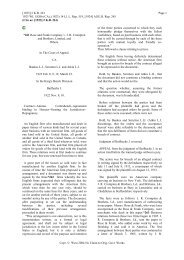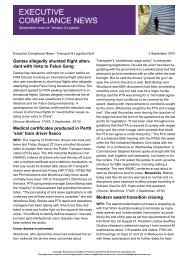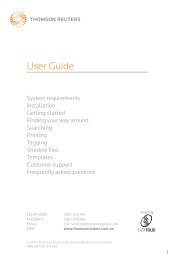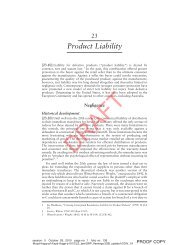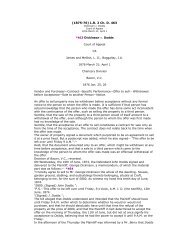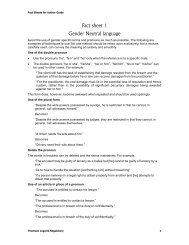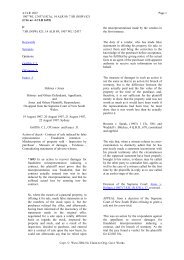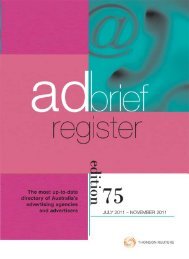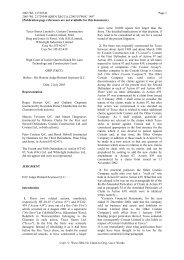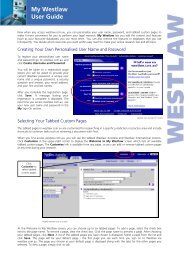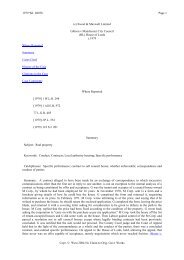Traffic Accidents Investigation preview.pdf - Thomson Reuters
Traffic Accidents Investigation preview.pdf - Thomson Reuters
Traffic Accidents Investigation preview.pdf - Thomson Reuters
You also want an ePaper? Increase the reach of your titles
YUMPU automatically turns print PDFs into web optimized ePapers that Google loves.
140<br />
<strong>Traffic</strong> accidents<br />
investigation, analysis and<br />
reconstruction<br />
updated by<br />
G Rechnitzer B Eng (Hons), M Eng Sc, PhD, MIEAust, CPEng,<br />
FSIA, MSAEA<br />
S Richardson B Eng (Mech), MSc (MVT), MIEAust, MSAEA<br />
A Short BA (Physics), MSc, BMED, D Phil (Oxon)<br />
T Orton B S Mechanical Engineering [UCSB]<br />
[Updating authors, Update 46, December 2008]<br />
by<br />
G Rechnitzer B Eng (Hons), M Eng Sc<br />
J Lenard B Eng (Hons), MA<br />
W Keramidas B App Sc, BA<br />
[Original authors]<br />
© 2008THOMSONREUTERS<br />
140 - 51<br />
Update: 46
EXPERT EVIDENCE<br />
The views expressed in this work are those of the authors.<br />
Although considerable care has been taken in regard to ensuring the accuracy of<br />
the work presented, the responsibility for the correct use, interpretation and<br />
verification of accuracy of any materials used must rest with the user.<br />
© 2008THOMSONREUTERS<br />
140 - 52<br />
Expert Evidence
Author information<br />
Dr George Rechnitzer is a partner and Principal Forensic Engineer with Delta-V<br />
Experts International Pty Ltd (see www.dvexperts.net) a Forensic Engineering and<br />
Safety Solutions consultancy. He has extensive experience in the application of the<br />
engineering sciences to safety in many areas including road safety, crashworthiness of<br />
all vehicle types, occupational health and safety, accident and incident investigation<br />
and reconstruction, analysis and countermeasure development for injury prevention. Dr<br />
Rechnitzer was a Senior Research Fellow at the Monash University Accident Research<br />
Center for some 12 years, and has carried out major projects for the Australian<br />
Defence Force, Vic Roads, Federal Office of Road Safety, Victorian Work Cover<br />
Authority and the Victorian Occupational Health and Safety Commission. He has also<br />
carried out a number of in-depth investigations for the State Coroner; consultancies on<br />
vehicle safety related projects for BHP, Australia Post, SECV and the Australian<br />
Industrial Relations Commission, amongst others. Dr Rechnitzer provides expert<br />
evidence for litigation cases in Australia and the USA, and his work has been published<br />
extensively with over 80 publications including contributing chapters in books relating<br />
to traffic accidents, accident investigation and reconstruction; and has made<br />
presentations at over 60 conferences and seminars, both nationally and at international<br />
forums.<br />
Dr Rechnitzer graduated in 1971 from Monash University with a Bachelor of<br />
Engineering (Civil) (Hons), has a Master Engineering Science degree from Melbourne<br />
University (1979), and a PhD from Monash University (2003). He is a Member of the<br />
Institution of Engineers and Sociey of Automotive Engineers, a Fellow of the Safety<br />
Institute of Australia and is Chair of its National Technical Panel.<br />
Dr Rechnitzer may be contacted at:<br />
Principal Forensic Engineer<br />
DVExperts International<br />
377 St Georges Road<br />
FITZROY NORTH VIC 3068<br />
AUSTRALIA<br />
Telephone: +61 (0)3 9481 2200<br />
Mobile +61 (0)418 998 158<br />
Fax + 61 (0)3 9481 2277<br />
Email: grechnitzer@dvexperts.net<br />
Website: http://www.dvexperts.net<br />
Shane Richardson is a partner and Principal Forensic Engineer with Delta-V Experts<br />
International Pty Ltd (see www.dvexperts.net) a Forensic Engineering and Safety<br />
Soultions consultancy. Shane has provided expert evidence in the Supreme, County<br />
and Magistrates Courts related to collision/incident investigations for rollover collisions,<br />
heavy equipment, tram collisions, boat collisions, vehicle dynamics, collision damage,<br />
crashworthiness, lines of sight, motorcycle collisions, bicycle collisions, pedestrian<br />
collisions, human impact, ballistics and vehicle data recorders. Shane is a Mechanical<br />
Engineer with 20 years experience in applying systems engineering methods to the<br />
procurement, specifications development, and design of automotive, military,<br />
mechanical and safety systems. Shane evaluated technical integrity issues such as:<br />
design, documentation, drawings, systems of work, maintenance and reliability and<br />
investigated equipment faults and failures.<br />
He has published national and international technical papers, and is currently<br />
© 2008THOMSONREUTERS<br />
140 - 53<br />
Update: 46
EXPERT EVIDENCE<br />
completing his PhD within the Civil Engineering Department, Monash University. The<br />
focus of his research thesis is Roll Over Protection Systems for 4x4 vehicles.<br />
Mr Richardson may be contacted at:<br />
DVExperts International<br />
377 St Georges Road<br />
FITZROY NORTH VIC 3068<br />
AUSTRALIA<br />
Telephone: +61 (0)3 9481 2200<br />
Mobile +61 (0)409 011 362<br />
Fax + 61 (0)3 9481 2277<br />
Email: srichardson@dvexperts.net<br />
Website: http://www.dvexperts.net<br />
Dr Andrew Short has been publishing, researching and practising in the area of<br />
biomechanics since 1995 and specialises in the application of statistical methods to<br />
establish the probability of injury in reported circumstances.<br />
Dr Short graduated from Trinity College Dublin (BA in Physics) and received<br />
scholarships to attend Imperial College London (MSc in Engineering and Physical<br />
Sciences in Medicine) and Oxford University where he received a Doctorate in<br />
Engineering Science, has spent two years as a Research Fellow at the Accident<br />
Research Centre, Monash University, where he conducted projects relating to arm<br />
fracture, serious spinal and head injury and developed strong industry links for<br />
investigating novel injury prevention devices. Dr Short is the Lecturer in cellular and<br />
tissue biomechanics at the University of Melbourne.<br />
Dr Short is a consutant biomechanics engineer and provides expert reports on cases<br />
of personal injury. These cases include determination of injury outcomes in the<br />
reported or reconstructed circumstances of a vehicle collision. Dr Short has specific<br />
skills in comparing injury outcomes for persons wearing and then not wearing a<br />
seatbelt and the reconstruction of pedestrian impacts where the standard throw<br />
distance calculations do not apply (MADYMO).<br />
In addition, Dr Short provides rounded, statistical, holistic and biomechanically sound<br />
analysis of work processes.<br />
Dr Short may be contacted at:<br />
Biomechanics Engineer<br />
DVExperts International<br />
377 St Georges Road<br />
FITZROY NORTH VIC 3068<br />
AUSTRALIA<br />
Telephone: +61 (0)3 9481 2200<br />
Mobile +61 (0)415984519<br />
Fax + 61 (0)3 9481 2277<br />
Email: ashort@dvexperts.net<br />
Website: http://www.dvexperts.net<br />
Tia Orton completed her Bachelor of Science Degree in Mechanical Engineering at the<br />
University of California in Santa Barbara (UCSB). While at UCSB, Tia held the coveted<br />
position of Undergraduate Teaching Assistant for Mechanical Engineering Drafting &<br />
Design. Following an internship at General Motors, Tia opted for a career in the field of<br />
independent transportation safety research with Safety Analysis and Forensic<br />
© 2008THOMSONREUTERS<br />
140 - 54<br />
Expert Evidence
Engineering (SAFE), a leading US automotive safety research firm.<br />
Throughout her six-year term at SAFE, Tia became extremely proficient in automotive<br />
crashworthiness analysis, research and litigation support. Tia’s work at SAFE included<br />
extensive analysis, testing and research related to vehicle rollover and other crash<br />
types. Much of the ground-breaking research that Tia encountered at SAFE was<br />
conducted by DVExperts International, leading to Tia taking a position working for<br />
DVExperts in Australia in October 2006.<br />
Since joining DVExperts, Tia has worked on many different cases ranging from car,<br />
motorcycle, truck and bus collisions, pedestrian impacts, rollovers, and structural and<br />
road design. Tia has also authored numerous peer-reviewed technical publications and<br />
has presented research to the US National Highway <strong>Traffic</strong> Safety Administration<br />
(NHTSA) on various subjects related to vehicle design.<br />
Ms Orton may be contacted at:<br />
DVExperts International<br />
377 St Georges Road<br />
FITZROY NORTH VIC 3068<br />
AUSTRALIA<br />
Telephone: +61 (0)3 9481 2200<br />
Fax + 61 (0)3 9481 2277<br />
Email: torton@dvexperts.net<br />
Website: http://www.dvexperts.net<br />
DVExperts is a forensic engineering and safety solutions company specializing in<br />
accident investigation and reconstruction, failure analysis, road safety, vehicle<br />
crashworthiness, workplace safety and safety solutions.<br />
© 2008THOMSONREUTERS<br />
140 - 55<br />
Update: 46
EXPERT EVIDENCE<br />
OVERVIEW ..................................................................................................................... [140.10]<br />
Accident reconstruction ..................................................................................................... [140.50]<br />
<strong>Traffic</strong> accident statistics for Australia ............................................................................... [140.90]<br />
Road safety – Historic trends ................................................................................ [140.100]<br />
Biomechanics in collisions............................................................................................... [140.140]<br />
Occupant motion in frontal collisions............................................................................... [140.180]<br />
Injury biomechanics in collisions ..................................................................................... [140.220]<br />
Crash test dummies and associated computer models ........................................ [140.230]<br />
Pedestrians in collisions .................................................................................................. [140.270]<br />
Injury criteria and tolerance levels for serious injury....................................................... [140.310]<br />
Crashworthiness and Australian design rules and standards......................................... [140.340]<br />
RECONSTRUCTION TECHNIQUES<br />
1.1 Introduction ........................................................................................................... [140.380]<br />
1.2 Crash scene ......................................................................................................... [140.400]<br />
1.3 Damaged vehicles ................................................................................................ [140.440]<br />
1.4 Tyre marks<br />
1.4.1 Introduction ................................................................................................... [140.460]<br />
1.4.2 Rolling prints ................................................................................................. [140.470]<br />
1.4.3 Skid marks .................................................................................................... [140.480]<br />
1.4.4 Scuff marks................................................................................................... [140.490]<br />
1.4.5 Friction and the tyre-road interaction............................................................ [140.510]<br />
1.5 Estimation of speed from skid marks................................................................... [140.550]<br />
1.5.1 Limitations..................................................................................................... [140.560]<br />
1.5.2 Accuracy ....................................................................................................... [140.570]<br />
1.6 Estimation of speed from yaw marks................................................................... [140.590]<br />
1.6.1 Determing the yaw radius............................................................................. [140.600]<br />
1.6.2 Limitations..................................................................................................... [140.610]<br />
1.6.3 Accuracy ....................................................................................................... [140.620]<br />
1.7 Measurement of friction........................................................................................ [140.640]<br />
1.7.1 Vehicle test skids .......................................................................................... [140.650]<br />
1.7.2 Limitations..................................................................................................... [140.660]<br />
1.7.3 Test skids using accelerometers................................................................... [140.670]<br />
1.7.4 Drag tyre and drag sled................................................................................ [140.680]<br />
1.7.5 The British portable skid resistance tester ................................................... [140.690]<br />
1.7.6 Friction values from tables............................................................................ [140.700]<br />
1.8 Leaps, flips and vaults<br />
1.8.1.1 Estimation of speed ................................................................................... [140.740]<br />
1.8.1.2 Limitations.................................................................................................. [140.750]<br />
1.8.1.3 Accuracy .................................................................................................... [140.760]<br />
1.9 Exterior vehicle damage ..................................................................................................<br />
1.9.1 Introduction ................................................................................................... [140.780]<br />
1.9.2 Structural performance ................................................................................. [140.790]<br />
1.9.3 Collision type ................................................................................................ [140.800]<br />
1.9.4 Crush profile ................................................................................................. [140.810]<br />
1.9.5 Estimation of speed from vehicle damage ................................................... [140.820]<br />
1.10 Interior vehicle inspection ..............................................................................................<br />
1.10.1 Seat belt use............................................................................................... [140.840]<br />
1.10.2 Intrusion ...................................................................................................... [140.860]<br />
1.11 Mechanisms of injury .....................................................................................................<br />
1.11.1 Signs of contact .......................................................................................... [140.890]<br />
1.11.2 Occupant motion and mechanisms of injury .............................................. [140.900]<br />
1.11.3 Other ........................................................................................................... [140.910]<br />
1.12 Computers and software .................................................................................... [140.930]<br />
1.13 Documentation.................................................................................................... [140.950]<br />
Case histories................................................................................................................ [140.1000]<br />
1.14 Civil cases ........................................................................................................ [140.1020]<br />
1.14.1 Train and truck, level crossing collision.................................................... [140.1020]<br />
1.14.2 Pedestrian impact ..................................................................................... [140.1030]<br />
1.14.3 Motorcycle and car collision ..................................................................... [140.1040]<br />
© 2008THOMSONREUTERS<br />
140 - 56<br />
Expert Evidence
TABLE OF CONTENTS<br />
1.15 Culpable driving................................................................................................ [140.1070]<br />
1.15.1 Two vehicle head on collision................................................................... [140.1070]<br />
APPENDIX 1: SYMBOLS AND GLOSSARY OF TERMS................................. [140.1100]<br />
APPENDIX 2: PERCEPTION AND REACTION TIME....................................... [140.1200]<br />
APPENDIX 3: FORCES AND LAWS OF MOTION ............................................ [140.1300]<br />
FIGURES..................................................................................................................... [140.1640]<br />
Authors’ Preface<br />
It has been over 10 years since the original chapter was written. It was motivated by the need<br />
for a much stronger foundation of science and engineering principles in the presentation of<br />
expert evidence in courts and tribunals for transport involved collisions.<br />
Since that time much has progressed in terms of road safety improvements [vehicle<br />
crashworthiness advances, road infrastructure investments and road rules and enforcement]. On<br />
the other hand the basic physics and engineering principles have, of course, not changed and<br />
thus the fundamentals of what we present in this updated chapter are retained, although we<br />
hope made clearer, with revisions added by Shane Richardson, Dr Andrew Short and Ms Tia<br />
Orton.<br />
Importantly the authors wish to acknowledge that this Chapter also owes its genesis in part to<br />
two of the previous co-authors Mr William Keramidas and Mr Jim Lenard.<br />
We have provided new case examples taken from the large number of cases we have done over<br />
the last few years. Dr Andrew Short has provided additional information on injury mechanism<br />
and biomechanics relating to collisions.<br />
We hope that this primer aimed at the legal fraternity, will be read by all who are involved in<br />
transport accidents and collisions. We welcome any feedback or queries, with contact details<br />
provided at the end of the Chapter.<br />
Please Note: The views expressed in this work are those of the authors. Although considerable<br />
care has been taken in regard to ensuring the accuracy of the work presented, the<br />
responsibility for the correct use, interpretation and verification of accuracy of any materials<br />
used must rest with the user.<br />
[The next text page is 140-1051]<br />
© 2008THOMSONREUTERS<br />
140 - 57<br />
Update: 46
EXPERT EVIDENCE<br />
© 2008THOMSONREUTERS<br />
140 - 58<br />
Expert Evidence
OVERVIEW<br />
[140.10] The many thousands of collisions which occur in Australia each year give rise to<br />
many actions, from property insurance claims, medical treatment, compensation claims,<br />
criminal charges for culpable driving, coronial inquests, product liability and other legal<br />
actions, road safety research and so on. The list is large. At the heart of many of these actions<br />
is the need to establish, as clearly and accurately as possible, particular and relevant details<br />
potentially relating to any phase of the incident. The result of the approximately 160,000<br />
tow-away crashes in Australia each year is around 1,600 fatalities and 46,000 serious injuries.<br />
Typical questions include, “How fast was the vehicle travelling”, “What was in its path”,<br />
“What action was taken by the driver”, “Who was driving”, “How did the vehicle design<br />
perform in terms of crashworthiness”, “How did the vehicles impact”, “How was the<br />
occupant injured” and so forth. Queries come from a host of interested parties, including<br />
insurance companies, police, coroners, road safety researchers, Federal and State regulatory<br />
authorities, vehicle owners, vehicle manufacturers and, of course, lawyers. The reasons for the<br />
queries can range from road safety research programs, product liability litigation, to driving<br />
prosecutions and insurance claims.<br />
<strong>Traffic</strong> accident reconstruction is aimed at providing the answers, if possible, to these<br />
questions.<br />
This chapter provides an introduction to the science of traffic accident investigation: analysis<br />
and reconstruction; current methodologies, procedures and limitations; expertise required; and<br />
questions for vetting expert witnesses. It is not intended – nor is it possible in the space<br />
available – to be a treatise on the subject, but it can provide those concerned with traffic<br />
accidents with a brief background and insight into what can be done, what information is<br />
needed and what questions need to be considered.<br />
With the great advances in techniques of computer analysis and graphic presentation, it is<br />
perhaps more important than ever not to confuse technical sophistication with accuracy and<br />
quality. Sophisticated technology may merely transform poor-quality data and analysis into<br />
impressive-looking but still poor-quality results. It is our objective to encourage the full and<br />
effective use of modern accident investigation techniques and also to sharpen the focus on<br />
ensuring that expert opinions, procedures and results are subject to due and appropriate<br />
scrutiny.<br />
Whilst experts can present technical reports and argue their position in Court, our experience is<br />
that lawyers, barristers, judges must also become more conversant with the principles outlined<br />
in this chapter. It remains a difficult and challenging exercise to present succinctly such science<br />
based material in court, where the science rather than the impression of science must be<br />
properly explained and completely understood by decision makers. This then leads to the<br />
further need for effective cross examination of experts based on a better understanding of the<br />
principles outlined in this Chapter. Thus our work as experts can often lose its full impact<br />
without the partnership of a technically well-informed legal team. Perhaps this is rather<br />
obvious; nonetheless it is vital that it is always recognised.<br />
Please refer to the appendices to this chapter in order to fully understand the explanations<br />
given below:<br />
Appendix 1: Symbols and Glossary of Terms<br />
© 2008THOMSONREUTERS<br />
140 - 1051<br />
Update: 46
[140.10] EXPERT EVIDENCE<br />
Appendix 2: Perception and Reaction time<br />
Appendix 3: Forces and Laws of Motion<br />
Appendix 4: Figures<br />
[The next text page is 140-1551]<br />
© 2008THOMSONREUTERS<br />
140 - 1052<br />
Expert Evidence



